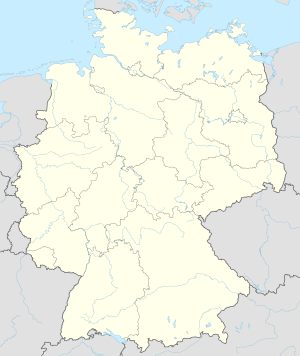Corvey Abbey
| Abbey of Corvey | |
|---|---|

The westwork of Corvey Abbey
|
|
| Basic information | |
| Geographic coordinates | 51°46′41″N 9°24′36″E / 51.778°N 9.41°ECoordinates: 51°46′41″N 9°24′36″E / 51.778°N 9.41°E |
| Municipality | Höxter |
| State | North Rhine-Westphalia |
| Year consecrated | 844 |
| Architectural style | Carolingian, High Romanesque, Baroque |
| Official name: Carolingian Westwork and Civitas Corvey | |
| Type | Cultural |
| Criteria | ii, iii, iv |
| Designated | 2014 (38th session) |
| Reference no. | 1447 |
| State Party | Germany |
| Region | Europe and North America |
The Imperial Abbey of Corvey or Princely Abbey of Corvey (German: Stift Corvey or Fürstabtei Corvey) was a Benedictine abbey on the River Weser, 2 km northeast of Höxter, now in North Rhine-Westphalia, Germany. It was one of the Imperial abbeys of the Holy Roman Empire from the late Middle Ages until 1792 when the abbey was dissolved and Corvey converted into a prince-bishopric. It was in turn secularized in 1803 and absorbed into the newly created Principality of Nassau-Orange-Fulda. In 2014, the former abbey was listed as a UNESCO World Heritage Site.
In the Saxon Wars which lasted more than thirty years after 772, Charlemagne, king of the Franks, was eventually victorious, adding the Saxon territory to his empire and starting the Christianisation of the Saxon people. To that end, bishoprics were established (at Hildesheim and Halberstadt). In addition, the idea of setting up an abbey in Saxony was first mooted during Charlemagne's rein. However, the plan was only implemented under his son, Emperor Louis the Pious, who announced the creation of an abbey east of the river Weser at a synod in Paderborn in 815. This was located at a place named Hethis. Although there is some uncertainty over the exact location, it is today thought to be near Neuhaus im Solling. The first monks arrived in 816 from the Benedictine abbey from Corbie Abbey in Picardy. They set up a Probstei, a subsidiary of the motherhouse. Due to the inappropriate location chosen, the monks chose to move in 822 - to the current location near what was then called Villa Huxori. The new house became known as Nova Corbeia (Latin for the "new Corbie"; Old German: Corvey pronounced [ˈkɔʁvaɪ]).
...
Wikipedia

